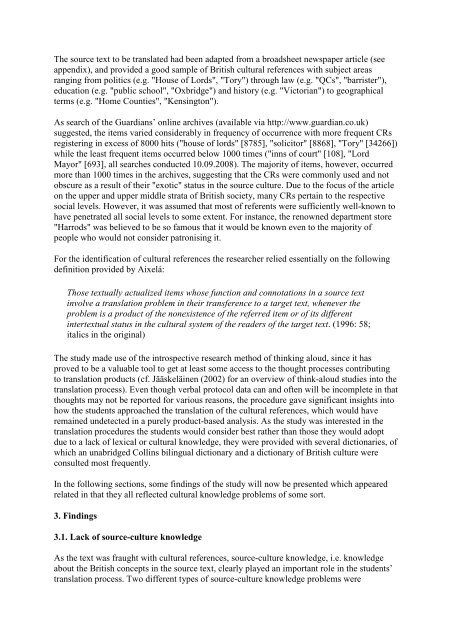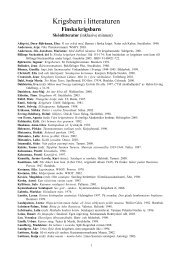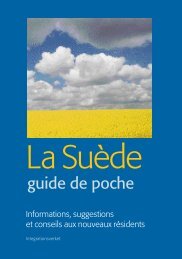Translation, Cultural Knowledge and Intercultural Competence
Translation, Cultural Knowledge and Intercultural Competence
Translation, Cultural Knowledge and Intercultural Competence
You also want an ePaper? Increase the reach of your titles
YUMPU automatically turns print PDFs into web optimized ePapers that Google loves.
The source text to be translated had been adapted from a broadsheet newspaper article (seeappendix), <strong>and</strong> provided a good sample of British cultural references with subject areasranging from politics (e.g. "House of Lords", "Tory") through law (e.g. "QCs", "barrister"),education (e.g. "public school", "Oxbridge") <strong>and</strong> history (e.g. "Victorian") to geographicalterms (e.g. "Home Counties", "Kensington").As search of the Guardians’ online archives (available via http://www.guardian.co.uk)suggested, the items varied considerably in frequency of occurrence with more frequent CRsregistering in excess of 8000 hits ("house of lords" [8785], "solicitor" [8868], "Tory" [34266])while the least frequent items occurred below 1000 times ("inns of court" [108], "LordMayor" [693], all searches conducted 10.09.2008). The majority of items, however, occurredmore than 1000 times in the archives, suggesting that the CRs were commonly used <strong>and</strong> notobscure as a result of their "exotic" status in the source culture. Due to the focus of the articleon the upper <strong>and</strong> upper middle strata of British society, many CRs pertain to the respectivesocial levels. However, it was assumed that most of referents were sufficiently well-known tohave penetrated all social levels to some extent. For instance, the renowned department store"Harrods" was believed to be so famous that it would be known even to the majority ofpeople who would not consider patronising it.For the identification of cultural references the researcher relied essentially on the followingdefinition provided by Aixelá:Those textually actualized items whose function <strong>and</strong> connotations in a source textinvolve a translation problem in their transference to a target text, whenever theproblem is a product of the nonexistence of the referred item or of its differentintertextual status in the cultural system of the readers of the target text. (1996: 58;italics in the original)The study made use of the introspective research method of thinking aloud, since it hasproved to be a valuable tool to get at least some access to the thought processes contributingto translation products (cf. Jääskeläinen (2002) for an overview of think-aloud studies into thetranslation process). Even though verbal protocol data can <strong>and</strong> often will be incomplete in thatthoughts may not be reported for various reasons, the procedure gave significant insights intohow the students approached the translation of the cultural references, which would haveremained undetected in a purely product-based analysis. As the study was interested in thetranslation procedures the students would consider best rather than those they would adoptdue to a lack of lexical or cultural knowledge, they were provided with several dictionaries, ofwhich an unabridged Collins bilingual dictionary <strong>and</strong> a dictionary of British culture wereconsulted most frequently.In the following sections, some findings of the study will now be presented which appearedrelated in that they all reflected cultural knowledge problems of some sort.3. Findings3.1. Lack of source-culture knowledgeAs the text was fraught with cultural references, source-culture knowledge, i.e. knowledgeabout the British concepts in the source text, clearly played an important role in the students’translation process. Two different types of source-culture knowledge problems were
















